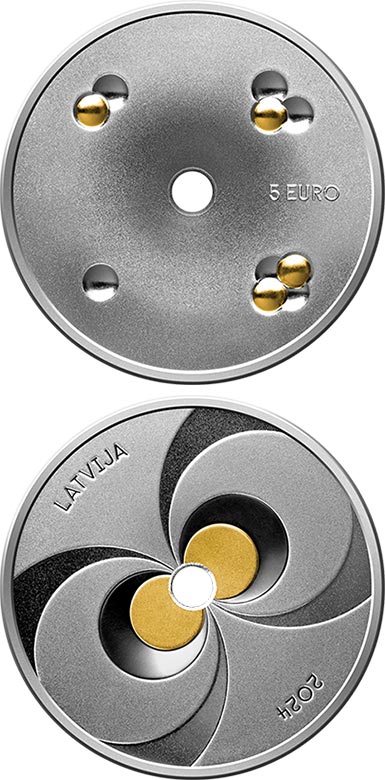5 euro - Energy Coin
Series: Latvia - Silver 5 euro coins

On Thursday, 26 September, Latvijas Banka will issue a collector coin dedicated to the role of science in our lives and the scientists' persistence in seeking answers to questions about the future of humanity.
By symbolically representing the process of nuclear fusion, the "Energy Coin" tells us about the biggest challenge of the modern world – the search for an inexhaustible source of energy to protect natural resources and achieve a balance between the whims of our age and the interests of future generations.
When developing the design of the coin, world-renowned designer Germans Ermičs consulted scientists to find the visual solution for depicting the fundamental laws of physics that allow for the existence of an almost limitless source of energy – the nuclei of light chemical elements. When smaller nuclei combine to form larger ones, a tremendous amount of energy is released in the form of heat, but to start and maintain this fusion reaction, a temperature of millions of degrees and the pressure to hold the matter together for a long enough time are needed. In nature, such extreme conditions occur in stars.
It is the fusion of hydrogen nuclei that powers the Sun and thus indirectly drives all the renewable energy sources on Earth. Nuclear fusion energy has two major advantages: virtually inexhaustible fuel resources and a neutral impact on the climate.
Turning the principle of nuclear fusion into a practical and widely available technology is a major scientific and engineering challenge that tens of thousands of researchers around the world have already been working on for a long time. Their task is the mission of Prometheus – to bring down the spark of the Sun from the heavens to serve people. The Treaty of the European Atomic Energy Community is one of the oldest European cooperation frameworks. Latvian scientists also participate in it with their contribution to the creation of the prototypes of the world's largest nuclear fusion reactors – ITER and its successor DEMO.
The silver collector coin issued by Latvijas Banka depicts the particles involved in the hydrogen fusion reaction. The beads depicted on the coin represent elementary particles that make up nuclei: the silver hollows are neutrons, while the gold-plated beads are protons. Hydrogen nuclei with one proton are the raw materials, while a helium nucleus with two protons and a free neutron are the products of the fusion reaction.
The main conditions for nuclear fusion are high temperature and pressure. In stars, the conditions for nuclear fusion are ensured by a strong gravitational field, while in nuclear fusion reactors, the hot plasma is held together by special magnetic fields. The arrangement of lines on the coin resembles both the magnetic fields of large space objects and the stylised cross-section of a toroidal fusion reactor – the so-called tokamak. The relief of the coin with a recess in the centre also echoes the gravitational potential near a star or a black hole.
The coin will be issued on Thursday, 26 September. Honouring the contribution of Latvian scientists to the research of nuclear energy, the University of Latvia, in cooperation with Latvijas Banka, is organising a lecture dedicated to nuclear fusion "How to Tame the Energy of the Future" and the presentation of the Energy Coin. At the event, the lecture will be delivered by researcher of the Europe's largest nuclear fusion experiment project ITER (France) Bertrand Roques, while the author of the Energy Coin and artist Germans Ermičs will delve into the process of creating its design. An expert discussion moderated by quantum physicist and Professor of the University of Latvia Vjačeslavs Kaščejevs is also to be held at the event to address the future of Latvia's nuclear fusion and the synergy of science and art. Anyone interested is invited to attend the event free of charge at 14:00 on Thursday, 26 September, at the House of Nature of the University of Latvia in Riga, Jelgavas iela 1.